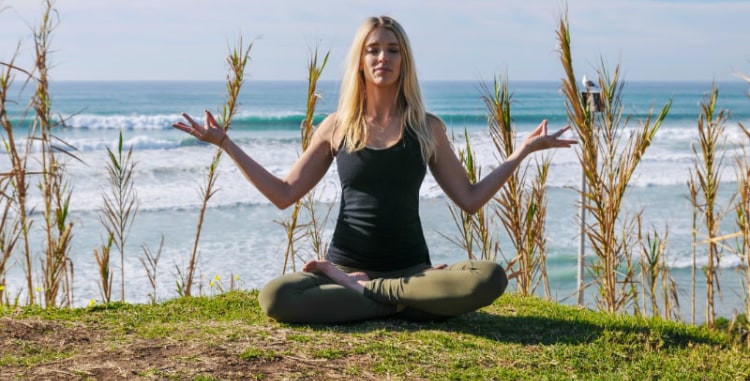
Thinking about doing a cleanse? There’s no better time than now. Here are 3 reasons why summer is the best time to do a cleanse.
Last week, I admitted that I indulged to the max while on my European vacation, and how when I got back home, I decided I needed to be a Chef V customer.
I’m happy to report that I just wrapped up a 7 Day Cleanse.
So far so good.
I don’t feel like I’m missing out at all.
In fact, I feel so good, I might do a 21 Day Detox.
And right now, in the heart of the summer, there’s no better time to do a cleanse or a longer detox.
Let me share with you my top 3 reasons why it’s easy to do a cleanse in summer.
Hack #1: take a walk
A simple way to have your blood sugar return to normal after a meal is by taking a walk. It doesn’t have to be a super vigorous hike, but getting enough exercise is important for managing diabetes and this is especially true if you’re sedentary for most of the day.
Even more important than the advice to exercise is learning when to exercise. And if you only have time (or the motivation) to move your body once per day, research strongly suggests you should do it after dinner.
Most people eat their heaviest meal at night. And the biggest spike in blood sugar occurs after eating a large meal, especially if it contains lots of carbohydrates that have the potential of converting into sugar. (Think: pasta, bread, rice and other starchy carbohydrates.) Walking after a heavy meal is a proven way to improve blood sugar levels.
Consider this study from New Zealand. Two groups of people, most of whom had type II diabetes for 10 years, were compared. One group walked for 30 minutes a day for two weeks. The other group went for a 10-minute walk after each main meal. The results: blood sugar levels were significantly lower when participants walked after meals compared with the group who only went for one walk a day.
Meanwhile a different study compares exercising before a meal and after. The group with the lower blood sugar levels exercised after their meal, not before. This supports the first study that it’s vital to move around after eating a meal.

Summer is Best Time To Do a Cleanse — Reason #1: You’re not as hungry
Ever watch a nature documentary that shows bears and other animals seemingly eating non-stop during the summer?
The reason bears and other creatures of the forest binge eat in summer is, of course, because they have to fatten up for the winter hibernation.
Sometimes in winter, I feel like hibernating.
But I also feel like eating a lot more in winter than I do in summer. The hot, sticky weather in summer kills the appetite, at least for hearty foods that we usually crave in the winter like stews, meat and starchy carbs such as pasta and bread.
Most people tend to crave fruit in the summer. And unlike meat and starchy carbs, fruit is a safe food to eat while doing a cleanse.
How I start off each morning while I’m doing a cleanse is drink two glasses of water. I like to add some electrolytes to the water to provide the energetic spark plug my cells need (pink sea salt does the trick).
About a half-hour later, I’ll have 16 oz of Organic Green Drink. Shortly after that, I’ll have a handful or so of berries.
This holds me over until it’s time for my vegan protein shake.
Even though I’ve done plenty of cleanses in winter with no problem, I have to admit that summer is my favorite season for detoxing. Simply for the fact that I’m usually not as hungry as I am in the winter.
But be careful to not exercise too much when you’re doing a cleanse in summer. You’re already limiting your calorie intake to begin with. Plus, with the heat, you’re at risk for heat stroke.
So just stick to walks early in the morning and/or evening.

Summer is Best Time To Do a Cleanse — Reason #2: Swimsuit Psychology
It might sound too good to be true. But we’ve had plenty of customer success stories with weight loss of 10 pounds or more within just 7 days.
Reading these success stories that make their way to my email inbox every day is a huge reason why I wake up excited to get to work.
I love hearing from women that a Chef V cleanse helped them look and feel sexier, especially in time for the summer swimsuit season.
Here’s what “Wenderful” says about her experience:
“I lost 10lbs!… This was the perfect start to leaning out for summer….Thank you Chef V….What a great experience!!
Now, I know what you might be thinking….
Sure, it’s great she was able to lose 10 pounds. But what’s going to happen once the cleanse is over?
Well, if “Wenderful” follows my cleanse daily schedule and post-cleanse tips, she’ll have no trouble keeping off the excess weight.
In winter, my hubby Brandon likes to joke that my legs need to be shaved with a lawn mower. Because of body consciousness, summer time gives us extra motivation to get leaner and look our best.

Summer is the best time to do a Cleanse
Reason #3: Salads
If you’re doing a cleanse or longer detox, one of the hardest things is going to a restaurant with friends.
However, in summer, it’s easy to join your friends at dinner. Just order a salad. Make sure to order the dressing on the side.
Most restaurants have at least one veggie they can steam or lightly grill for you, such as broccoli or asparagus.
A large spinach salad (no croutons!) with a side of veggies will fill you up. And because of the hot weather, you’re not going to feel like sinking your teeth into a burger like your friends.
If you’re having a hard time losing those last stubborn 10 pounds, there is no better time to do a Chef V cleanse than right now.
Do it now because in the blink of an eye, you’re going to feel like hibernating. And when that happens, you won’t have the luxury of sleeping the winter off like a bear. You’ll be craving high-calorie foods to make it through those long dark nights.



























